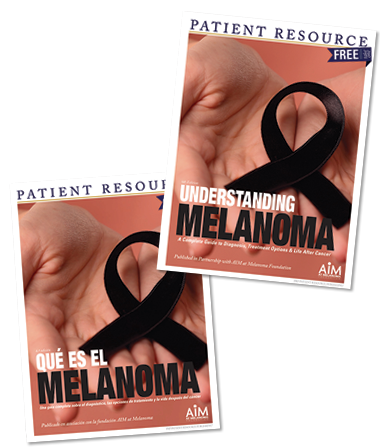
Melanoma
Life After Cancer
Survivorship is the term many use to describe the journey that begins with a cancer diagnosis and lasts for the rest of your life. After you complete treatment, your path changes. It is one that concentrates on maintaining your physical health as well as your mental well-being. Develop and follow a survivorship plan to help you focus on these priorities.
What is a Survivorship Plan?
You can think of it as a life wellness plan. You may question whether you need a plan. You managed to live without one before, right? This really is different because there are many parts of your life that have changed since you were diagnosed with melanoma. A melanoma survivorship plan includes resources that can help you cope with long-term physical and emotional effects from treatment; manage your risk for recurrence or a second melanoma; address social and financial concerns; find support and community resources and improve your quality of life.
Your doctor may provide you with a survivorship plan. Some cancer centers offer survivorship programs. If neither are available to you, you can create a survivorship plan on your own. This information can help doctors who are unfamiliar with your care provide you the best possible care in the future.
Medical history. You may be able to fill in most of the information on your own, but it is important to follow up with your health care team about each part of the plan. Include the following components.
- Your cancer diagnosis, including the date of diagnosis and the type, stage and location of your cancer, as well as a full medical history.
- Your medical treatments, including drug names, dosages, dates and any side effects; include ongoing maintenance therapy.
- Your diagnostic test results.
- Your symptoms.
- Supportive care you have received, such as emotional counseling.
- Your family’s medical history, including any history of cancer.
Late effects. Late effects are side effects that may last or show up weeks, months or even years after your treatment ends. Be sure to ask your health care team about the possible signs and symptoms so you can detect and manage them early.
Risk for recurrence. Ask about your risk for cancer coming back and the symptoms that may signal a recurrence.
Follow-up schedule. This may include information about future appointments, diagnostic tests and exams to monitor for signs of a recurrence or another cancer. Include any other procedures, such as reconstruction, that are part of your overall treatment plan. If you had a larger tumor removed, for example, a plastic surgeon may repair it with reconstructive techniques. It is important to conduct self-exams in between follow-up appointments. Putting them on your plan will serve as a reminder to do them.
If your doctor doesn’t tell you how often to come back for checkups, ask. Your survivorship plan needs to be complete to be effective.
Re-Entering The World

The idea of getting back to a pre-cancer life may be exciting, but it may also be somewhat scary. Following are suggestions to help you during the transition.
Healthy Lifestyle. Staying healthy and being active is an important part of survivorship. Eating right and exercising continue to offer multiple health benefits and help you build a solid foundation for going forward. Consider the following:
- Work with a dietitian to create healthier eating habits
- Maintain or start an exercise plan. Be sure to discuss your plan with your doctor.
- Quit smoking and stop using tobacco products
- Wear sunscreen every time you go outside
Returning to work. You may have altered your work schedule or taken a leave of absence during treatment. Consider resuming your former responsibilities as they were or explore changes that could make it easier or more comfortable for you. Work with your supervisor and refer to the Americans with Disabilities Act to know your rights in the workplace. You may have long-term effects that could require some short-term changes such as these:
- A flexible schedule or reduced hours
- A redesigned workstation
- The ability to work from home
- Different responsibilities
Going back to class. Stay in touch with the faculty so they know when to expect you back. Consider stopping by before returning full-time to see if any accommodation, such as extra time between classes, having two sets of textbooks so you can keep one set at home, and being excused from a physical education class, can be made.
You may have anxiety about going back, and that is normal. Your school or workplace may offer emotional and social support resources to help with your transition.


